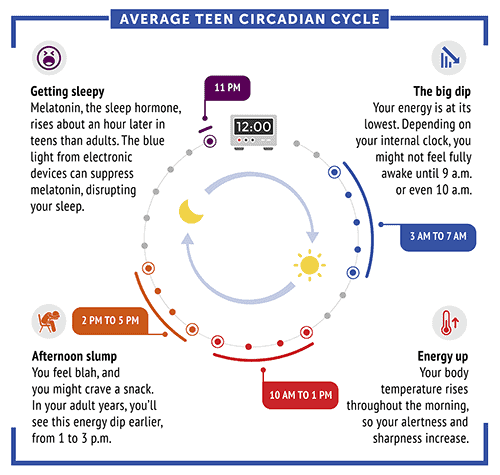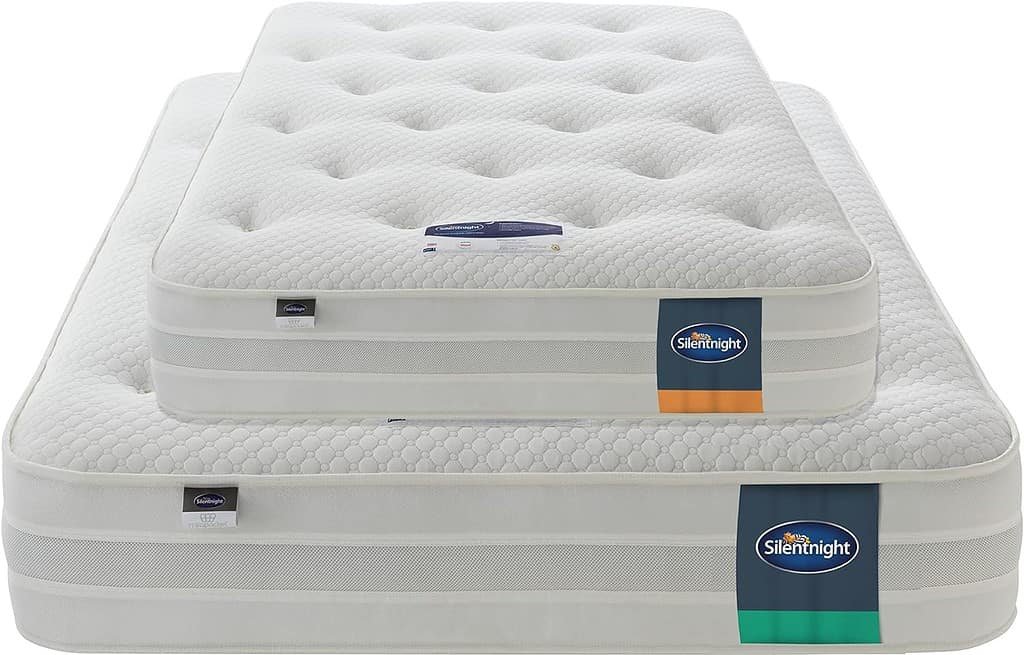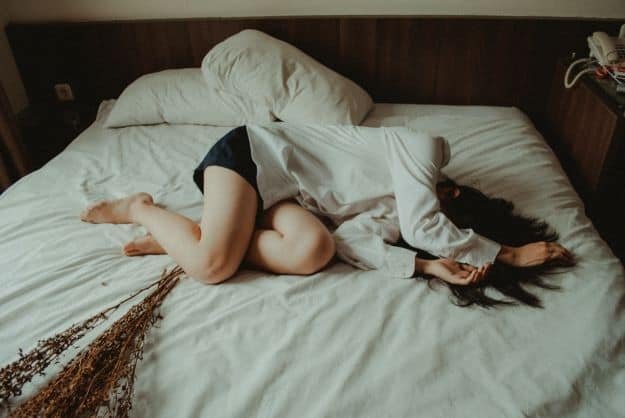What Is Circadian Rhythm and How Does Your Sleep System Work?
It is surprising how much sleep we still don’t understand, given how much research has been done on the subject. We know it’s essential to a healthy life, there are different sleep stages, and we know it’s vital for your brain functions, yet we still don’t understand many areas. However, Circadian Rhythm is one area we can claim to have a reasonably good handle on. This Rhythm is familiar to most lives and controls our schedule for sleeping and being awake. It is tied to our body clocks, and changes can be triggered by environmental factors, primarily light and darkness.
These changes trigger hormonal changes, and these hormones make you feel sleepy and tell your brain it is time to get some rest. The hormone that is most closely associated with this process is Melatonin. Unfortunately, this cycle is easily disrupted; jet Lag is commonly cited as an example of when your Circadian Rhythm gets messed about. But increasingly modern life, with its 24-hour day lifestyle, electric lighting, and blue light from phones, tablets and computers, all can play havoc with your Circadian Rhythm. This article sets out to give you an understanding of the Circadian Rhythm, how it works and how you can ‘reset it’ when it goes awry.
How Does Your Circadian Rhythm Work?
Your Circadian Rhythm is one of four identified distinct biological rhythms in the body; three are closely tied: your Circadian Rhythms, Diurnal Rhythms and Ultradian Rhythms. To one degree or another, each of these rhythms is linked to sleep patterns. The other biological Rhythm is called the Infradian Rhythm, and it operates in cycles of greater than 24 hours and governs such aspects as menstrual cycles. Looking specifically at Circadian Rhythms, we understand many of the factors that trigger actions, including:

Brain Cell Reactions to Light and Dark
Evolution has designed us to be diurnal, that is, creatures of the day. When it’s dark, we get sleepy; the reason for this is cells in your brain that respond to changes in light. Vision is an integral part of this; the eyes pass the messages of the change in environment to the brain; the brain then triggers further reactions that ultimately culminate in releasing specific hormone types.
Hormones
When considering the Circadian Rhythm that drives sleep patterns, the vital hormone at play is called Melatonin. This is the hormone that decides your sleep pattern; it is what makes you feel sleepy. When the brain receives ‘dark’ signals, it releases more Melatonin. The opposite happens as the ‘signals’ get lighter. On this cue, the brain begins suppressing Melatonin and releasing its nemesis, Cortisol. Cortisol has the opposite effect of Melatonin; Cortisol heightens your alertness. This is the primary mechanism at the heart of the Circadian Rhythm, but several other factors are closely associated with it. As well as sleep schedule, Circadian Rhythm also helps regulate functions like:
- Appetite
- Blood Pressure
- Reaction Times
- Body Temperature
Your Circadian Rhythms also function differently depending on age, and this is what we will consider next.
Newborn Circadian Rhythm
As any parent will tell you, the first few months of looking after that new baby are generally sleepless. It is almost like that darling child hasn’t got any sleep pattern. There is a reason for this; they haven’t! That first few months of life is the only time we haven’t felt the influence of the Circadian Rhythm. Babies only begin to develop their Circadian Rhythm as they adapt to their new environment. Most newborns are at least three months old before their brain begins to release Melatonin; for Cortisol, the wait can be up to 9 months, although, in some instances, it can start being released as early as two months.
Once the Circadian Rhythm has established itself, a child’s sleep pattern usually stabilises, and they settle down to a few years of sleeping 9 to 10 hrs. a night. The child requires more sleep at this age, and the Circadian Rhythm of toddlers and children is the driving factor in this pattern.
Teenage Circadian Rhythm
It goes from wishing your baby would sleep to trying to drag your teenager out of bed in the morning. Once again, the Circadian Rhythm is at the heart of this change. Teenagers have gone through a stage called the Sleep Phase Delay. This is just what it sounds like; in this stage, the release of the Melatonin Hormone is delayed.
Teenagers’ body clocks don’t shift to a sleep phase until at least 10.00 p.m., sometimes much later. This is why persuading a teenager it is time for bed is complex; in truth, it probably isn’t time for bed, at least as far as their Circadian Rhythm goes. Ironically, teenagers still require as much sleep as younger children. This is why getting them out of bed in the morning is a painful experience for everyone involved.
Adult Circadian Rhythms
By reaching adulthood, you should have achieved that healthy Circadian Rhythm we are familiar with. In most cases, this will regulate between 7 and 9 hours of sleep per night and start us yawning sometime before midnight. There are still many countries worldwide where people stop for an afternoon siesta. There is an argument that this is part of our natural cycle and something we should all be doing.
Our Circadian Rhythms certainly agree because we feel most tired between 2.00 a.m. and 4.00 a.m. Adults also experience another weary period between 1:00 p.m. and 3:00 p.m. Your Circadian Rhythms also change as you age; the older you get, the earlier you begin to feel tired. This is quite normal and affects the mornings, so older adults rarely lie in bed all morning.
Circadian Rhythm and Sleep Disorders
Your sleep/wake cycle is governed by a body clock called your Circadian Rhythm. Sleep disorders that are caused by a disruption to this are referred to as Circadian Rhythm Sleep Disorders.
Some symptoms of Circadian Rhythm Sleep Disorders include:
- Not feeling refreshed after sleeping
- Difficulty in achieving sleep.
- Difficulty in staying asleep.
- Daytime Tiredness
- Depression
The top three of this list are the most common, and most people with Circadian Sleep Disorders will experience at least one, if not all, of these symptoms.
Circadian Rhythm Sleep Disorder Types
Classification of a sufferer’s type of sleep disorder is based on their sleep patterns.
Delayed Sleep Phase Syndrome (DSPS)
This condition is most common among young adults and adolescents. As the name suggests, this condition is a manifestation of the Sleep Phase Delay; in some instances, it is merely that the individual hasn’t grown out of the phase; in others, it may have begun later in life or has re-manifested itself. This is widespread, with about 5 to 20% of the population likely to be sufferers. If someone tells you they are a Night Person, they probably tell you they suffer from DSPS. Commonly, people with this disorder will stay up later at night and either get up later or be prone to sleeping in the mornings.
Advanced Sleep Phase Disorder (ADS)
At the other end of the spectrum lies ADS; this disorder usually affects older individuals and is more or less the opposite of DSPS. People with this disorder tend to go to bed earlier and rise earlier; in extreme circumstances, it could mean bed as early as 6:00 p.m. and wide awake at 2:00 a.m. Mostly, it isn’t quite as severe as this.
Jet Lag Disorder
This usually is a temporary condition caused by travelling (quickly) from one time zone to another. It can take your Circadian Rhythms time to adjust to this change. This is perhaps one of the best-known sleep disorders, and the causes are well understood. Luckily for most people, the adjustment happens quickly, and the effects generally lessen after a few days.
Shift Work Disorder
People with this disorder struggle to sleep during the day, even after coming off a long and tiring shift. Increasingly, we are becoming a 24-hour society, and more of us are working night shifts and later hours. This throws your Circadian Rhythms off-kilter for apparent reasons; your body wants to sleep at night and work during the day.
Non-24hr Disorder
Often referred to as Non-24, this disorder is more severe than the others. The underlying cause is the brain’s inability to recognise or react to the visual stimulus that drives Circadian Rhythms. People suffering from this disorder have irregular sleeping patterns, which could mean the sufferer is often awake at night and sleeps through the day.
This condition often has underlying causes, including learning difficulties, Blindness and Dementia.
Irregular Sleep/Wake Disorder (ISWD)
This is another one exactly as it sounds; people suffering from this condition have extremely irregular sleep patterns. Instead of getting their sleep in one block, as most of us do, they tend to sleep a little at a time but frequently.
Usually, this involves at least three sleep episodes per day, although it could be many more in extreme cases. In between these sleep periods, symptoms include chronic insomnia and exhaustion. This disorder is frequently associated with neurological conditions such as Dementia.
How to Reset and Maintain a Healthy Circadian Rhythm
It might sound all doom and gloom when we look at these sleep disorders, however, except for the last two, which may need medical intervention. We can do a lot to help ourselves and have plenty of good reasons.
Many disorders, like Jet Lag and shift work disorders, will be temporary. Others may well be grown out of. If, however, you suffer from a Circadian Rhythm Sleep disorder, there are many reasons for you to try and remedy the situation, as well as affecting your sleep; these disorders can also cause:
- Cardiovascular Problems
- Metabolism Issues
- Depression
- Skin Problems
And many other problems have been associated with sleep disorders. Here are a few simple, common-sense steps to alleviate sleep issues.
- Light your life as naturally as possible, ensure you get plenty of light during regular daylight hours (even if it means turning household lights on during the day), and keep the light dimmer at night.
- Go for brisk walks during the day.
- Avoid bright lights at nighttime; if your phone and computer have ‘night modes,’ use these to avoid getting too much blue light at night.
- Avoid stimulants like caffeine and nicotine.
- Try to get into a regular sleep/wake cycle.
If you suffer from a severe sleep disorder you should consult with a medical professional.



